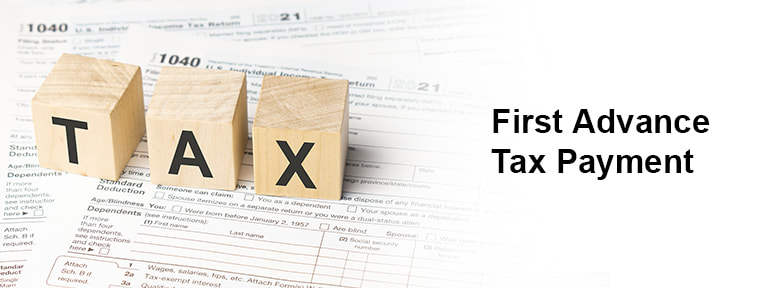
First Advance Tax Payment Due on 15th June: What You Need to Know
Posted on Thursday, June 12th, 2025 | By IndusInd Bank
The deadline to pay the first advance tax installment for Financial Year 2025–26 is fast approaching. If your estimated tax liability for the year exceeds ₹10,000, the Income Tax Act requires you to pay taxes in instalments rather than waiting for year-end filing.
Advance tax helps the government receive tax collections throughout the year. And it can help you avoid a large lump-sum outflow later. In this blog, we’ll walk you through who needs to pay advance tax, how much is due by 15th June, and how you can pay it—online or offline. Let’s get started with the basics.
What is Advance Tax?
Advance tax refers to income tax paid in parts during the financial year, instead of making a single payment at the end. Also known as “pay-as-you-earn” tax, it’s applicable to individuals and businesses whose total tax liability exceeds ₹10,000 in a financial year.
The income on which advance tax is paid can include salary, rent, interest, capital gains, business income, or other taxable earnings.
Who Needs to Pay Advance Tax?
Advance tax applies to:
- Salaried individuals with additional income from sources like rent or capital gains
- Freelancers and consultants
- Business owners, including those under the presumptive taxation scheme
- Companies and partnership firms
Exemption:
- Resident senior citizens (aged 60 or above) not having income from business or profession are exempt from paying advance tax, even if their tax liability exceeds ₹10,000.
| Note: If you’re unsure about your eligibility, it’s best to consult a qualified tax advisor or refer to the Income Tax Department’s official website. |
Why is it Important to Pay Advance Tax on Time?
Paying advance tax on time can benefit you in multiple ways:
- Avoid interest penalties under Sections 234B (for non-payment) and 234C (for delay) of the Income Tax Act
- Distribute your tax burden across the year rather than paying a lump sum at filing time
- Stay compliant with tax regulations and avoid notices for delayed or insufficient payments
Missing the June 15th deadline may attract interest charges, so it’s important to stay ahead of your obligations.
Also Read: Advance Tax Payment in India: Everything You Need to Know
Advance Tax Due Dates for FY 2025–26
If your estimated tax liability exceeds ₹10,000 in the financial year, you’ll need to pay advance tax in four instalments. Here’s the schedule prescribed by the Income Tax Department:
| Due Date | Minimum Advance Tax Payable |
| 15th June 2025 | At least 15% of total liability |
| 15th September 2025 | At least 45% of total liability (cumulative) |
| 15th December 2025 | At least 75% of total liability (cumulative) |
| 15th March 2026 | 100% of total liability (final installment) |
| Quick Tip: These are cumulative targets. If you underpay in earlier quarters, you can make up for it in the next one—but interest may apply. |
What if You Miss the 15th June Deadline?
Missing the first installment doesn’t go unnoticed. Here’s what could happen:
- Interest under Section 234C: You may be charged interest for shortfall in the required 15% installment.
- Higher burden later: Future instalments will need to cover the missed portion, increasing your cash outflow in one go.
- Reduced tax planning flexibility: Timely payments let you better plan deductions and cash flows.
| Quick Tip: Avoid missing deadlines by setting calendar reminders or automating alerts via banking or tax platforms. |
How to Calculate Your First Advance Tax Installment
Here’s a simplified process to estimate how much you need to pay by 15th June:
1. Estimate your total income for FY 2025–26, including:
- Salary
- Interest (FDs, savings, etc.)
- Rental income
- Business or professional income
- Capital gains (if any)
2. Subtract eligible deductions, such as under
- Section 80C
- Section 80D
- Standard Deductions
You will get your taxable income
3. Apply the applicable tax slab rates for individuals or businesses on your taxable income.
4. Deduct TDS (if any) already deducted by your employer, bank, or other sources.
5. If net payable tax exceeds ₹10,000, calculate 15% of that amount as your first advance tax installment.
Example: First Advance Tax Installment Calculation
Suppose Mr. Rajesh has the following estimated details for FY 2025–26:
- Gross total income (e.g., salary, interest, professional fees) = ₹ 8,10,000
- Add Interest from fixed deposits = ₹ 10,000
- Total income = ₹ 8,20,000
- Less Deduction under Section 80D (health insurance premium): ₹ 77,000
- Net taxable income = ₹ 7,43,000
Let’s calculate his tax liability based on the old tax regime:
1. Income tax on ₹ 7,43,000 (old regime slabs):
- ₹ 0 – 2,50,000: 0% ⇒ ₹ 0
- ₹ 2,50,001 – 5,00,000: 5% ⇒ ₹ 12,500
- ₹ 5,00,001 – 7,43,000: 20% ⇒ ₹ 48,600
- Total income tax: ₹ 61,100
2. Add health & education cess (4%):
- 4% of ₹ 61,100 = ₹ 2,444
- Total tax liability: ₹ 63,544
3. First advance tax installment (15%) due by 15 June 2025:
- 15% × ₹ 63,544 = ₹ 9,532
| Note: The example above is for illustration only. For precise calculations, consider using the official Income Tax Department calculator or consulting a tax professional. |
How to Pay Advance Tax Online
You can pay your advance tax online through the official e-filing portal. Here’s how:
Step 1. Visit https://www.incometax.gov.in
Step 2. Go to ‘e-Pay Tax’ under the ‘Quick Links’ section.
Step 3. Enter your PAN and Mobile number. Enter the OTP received on the registered mobile number.
Step 4. Select the box labeled ‘Income Tax’.
Step 5. Enter all the tax-related information and then click on ‘Continue’.
Step 6. Choose your preferred mode of payment (Net banking, debit card, UPI, etc.)
Step 7. Preview the challan to re-verify the details. You can also edit details if required, else, you can confirm the payment.
Step 7. Save the payment receipt (which has the BSR code and challan serial number) for your records.
| Quick Tip: Always double-check the assessment year and PAN details before submitting the payment. |
How to Pay Advance Tax Offline (at a Bank Branch)
Prefer paying your taxes the traditional way? Here’s how to do it offline:
- Visit an authorised bank branch (most private and public sector banks are authorised to accept direct tax payments).
- Ask for the Challan from the counter.
- Fill in the details carefully:
- PAN
- Assessment Year (2026–27)
- Type of payment: Advance Tax (code 100)
- Submit the filled form along with the tax amount via cash, cheque, or demand draft.
- The bank will give you a stamped counterfoil as acknowledgment of payment. Keep it safely for your records or future reference.
| Quick Tip: Check if your branch accepts tax payments—some may only process them on specific days or timings. |
Documents You May Need for Advance Tax Payment
Whether you’re paying online or offline, keep the following handy:
- PAN card
- Estimated income and deduction details
- Bank account with internet banking or UPI access (for online payment)
- Form 26AS (optional, to check TDS already deducted)
- Challan 280 (for offline payment)
Things to Keep in Mind before Paying Your First Advance Tax Installment
A few quick checks can make the process easier:
- Ensure your PAN is active and linked to Aadhaar
- Choose the correct assessment year: FY 2025–26 = AY 2026–27
- Avoid underestimation—it may lead to penalties later
- Keep proof of payment (challan or transaction ID) for ITR filing
- Consider using the Income Tax Department’s official calculator for better estimates
Wrapping Up!
Paying your first advance tax installment by 15th June 2025 not only helps you stay on the right side of the tax authorities but also reduces the financial burden later in the year. Whether you’re a salaried individual with side income, a freelancer, or a business owner, understanding how advance tax works can help you plan your finances better. This blog is intended to help you understand the process—but for specific tax guidance, always consult a qualified tax advisor.



 Offers
Offers Rates
Rates Debit Card Related
Debit Card Related Credit Card Related
Credit Card Related Manage Mandate(s)
Manage Mandate(s) Get Mini Statement
Get Mini Statement
 categories
categories Bloggers
Bloggers Blog collection
Blog collection Press Release
Press Release


